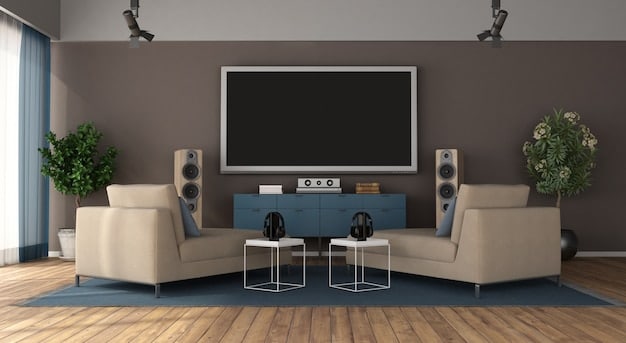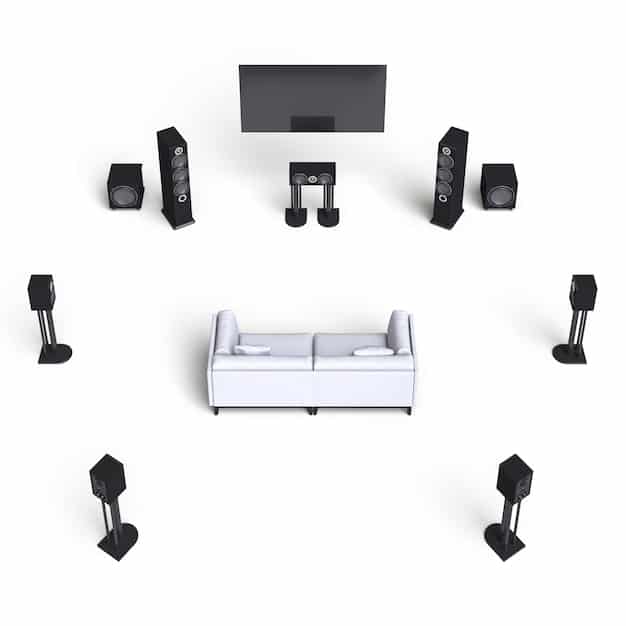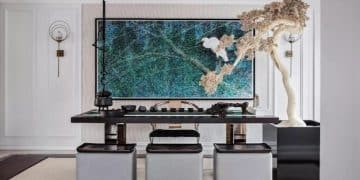Smart Home Theater Setup: A Beginner’s Guide to Immersive Entertainment

Setting up a smart home theater system involves selecting the right components, connecting them properly, and optimizing settings for an immersive entertainment experience, all while integrating seamlessly with your smart home ecosystem.
Turning your living room into a cinematic paradise is easier than you might think. This step-by-step guide shows you how to set up a smart home theater system: a step-by-step guide for beginners, ensuring you get the most out of your viewing experience.
Choosing the Right Components
The foundation of any great home theater is the equipment you select. From the display to the sound system, each element plays a crucial role in delivering an immersive experience. Let’s explore the key components you’ll need.
Selecting a Display: TV vs. Projector
The first decision you’ll need to make is whether to go with a traditional television or a projector. Each has its pros and cons.
Television: TVs offer excellent brightness, color accuracy, and are generally easier to set up. Look for models with 4K resolution and HDR (High Dynamic Range) for the best picture quality.
Projector: Projectors can create a truly cinematic experience with a much larger screen size. However, they require a darkened room and a suitable screen.
Audio Options: Soundbars, Receivers, and Speakers
Audio is just as important as video. You have several options to choose from:
- Soundbars: Simple to set up and take up minimal space, soundbars are a great option for smaller rooms or those who prefer a clean look.
- Receivers and Speakers: A receiver paired with multiple speakers (e.g., 5.1 or 7.1 surround sound) offers the most immersive audio experience. This setup provides distinct channels for sounds, enhancing the realism of movies and games.
- Wireless Speakers: Wireless speakers offer flexibility and ease of placement. Many smart speakers can also integrate into a home theater setup.
Streaming Devices and Smart Home Integration
To make it “smart,” you’ll want a streaming device and a way to integrate it with your smart home ecosystem:
- Streaming Devices: Devices like Apple TV, Roku, or Amazon Fire Stick provide access to streaming services, apps, and more.
- Smart Home Hubs: Consider using a smart home hub like Amazon Echo or Google Home to control your devices with voice commands.
Choosing the right components involves considering your budget, room size, and desired level of immersion. Balance picture quality with sound and smart home integration for a cohesive experience.
Planning Your Room Layout
Room layout is crucial for both visual and auditory experiences. Proper placement of your screen, speakers, and seating can drastically improve your home theater. Careful planning helps you maximize space and minimize potential distractions.
Screen Placement and Viewing Distance
The distance between your seating and the screen is vital for comfortable viewing. Too close, and you’ll strain your eyes; too far, and you’ll miss details.
- Optimal Viewing Distance: A general rule is to multiply the screen size (diagonal measurement) by 1.5 to 2.5. For example, a 65-inch TV should be viewed from approximately 8.1 to 13.5 feet away.
- Screen Height: Mount your TV or projector screen so that the center is at eye level when seated.
Speaker Placement for Surround Sound
Proper speaker placement is key for creating an immersive surround sound experience. Here’s a typical setup:
Front Speakers: Place the left and right front speakers equidistant from the center of the screen and angled towards the listening area.
Center Speaker: Position the center speaker directly above or below the TV, aligned with the center.

Surround Speakers: Place surround speakers to the sides or slightly behind the listening position, facing inward.
Subwoofer: The subwoofer can be placed anywhere in the room, but corners often provide the most bass response.
Managing Cables and Power
A clean setup is not only aesthetically pleasing but also safer:
- Cable Management: Use cable ties, sleeves, or wall-mounted raceways to keep cables organized and out of sight.
- Power Outlets: Ensure you have enough power outlets for all your devices. Consider using a surge protector to protect your equipment.
Thoughtful room layout enhances both the visual and auditory aspects of your home theater. Consider viewing distances, speaker placement, and cable management to create a comfortable and immersive environment.
Connecting Your Devices
Connecting your devices correctly is essential for getting the best performance from your home theater system. This involves understanding different cable types and ensuring your components are properly linked.
Understanding HDMI, Optical, and RCA Cables
Different cables serve different purposes:
HDMI (High-Definition Multimedia Interface): Carries both video and audio signals. Use HDMI for connecting your streaming device, Blu-ray player, and gaming console to your TV or receiver.
Optical (Toslink): Transmits digital audio signals. Use optical cables for connecting your TV to a soundbar or receiver.
RCA: Older analog cables that transmit audio. While still used in some devices, HDMI and optical are generally preferred for better quality.
Connecting Your Source Devices to the Receiver/TV
Follow these steps to connect your source devices:
- Plug your streaming device, Blu-ray player, and gaming console into the HDMI inputs on your receiver or TV.
- If using a receiver, connect the receiver’s HDMI output to your TV’s HDMI input.
- Connect your TV to your soundbar or receiver using an HDMI or optical cable for audio output.
Setting Up Audio: Speaker Wiring and Configuration
Proper speaker wiring is crucial for surround sound. Connect your speakers to the receiver using speaker wire. Match the positive (+) and negative (-) terminals on the speakers and receiver to avoid phase issues.
Once connected, configure your receiver to recognize the number and placement of your speakers. This setting is usually found in the receiver’s menu.
Connecting your devices correctly ensures you get the best possible audio and video quality. Take the time to understand the different cable types and follow the connection steps carefully.
Calibrating Your System
Calibrating your home theater system optimizes the picture and sound settings for your specific room. This fine-tuning process ensures you’re getting the most accurate and immersive experience possible.
Adjusting Picture Settings on Your TV/Projector
Most TVs and projectors come with preset picture modes, but these often aren’t ideal for all content or viewing environments.
- Brightness and Contrast: Adjust these settings so that blacks are deep and whites are bright, without losing detail in either extreme.
- Color: Calibrate the color settings to ensure accurate and natural skin tones.
- Sharpness: Increase sharpness sparingly. Too much can create unwanted artifacts.
Configuring Audio Settings on Your Receiver
Your receiver offers several audio settings to optimize sound:
- Speaker Levels: Adjust the volume level of each speaker to ensure a balanced soundstage.
- Crossover Frequency: Set the crossover frequency to direct low-frequency sounds to the subwoofer.
- Surround Sound Mode: Experiment with different surround sound modes (e.g., Dolby Atmos, DTS:X) to find the one that sounds best for your room and preferences.

Using Calibration Tools and Apps
For more precise calibration, consider using calibration tools or apps:
- Calibration Discs: These discs play test patterns that help you adjust your picture settings.
- Calibration Apps: Some apps use your smartphone’s camera and microphone to analyze your room and suggest optimal settings.
Calibrating your system ensures that you’re getting the most accurate and immersive experience possible. Experiment with picture and sound settings, and don’t be afraid to use calibration tools to fine-tune your home theater.
Integrating Smart Home Features
Integrating smart home features can take your home theater to the next level. From voice control to automated lighting, these integrations enhance convenience and create a more immersive atmosphere.
Voice Control Integration (Amazon Alexa, Google Assistant)
Voice control allows you to operate your home theater system hands-free:
Amazon Alexa: Connect your streaming device, receiver, and smart lights to Alexa for voice control.
Google Assistant: Control your devices with Google Assistant by linking them to your Google Home hub.
You can use voice commands to turn on/off devices, adjust volume, switch inputs, and control smart lights.
Automated Lighting and Smart Blinds
Automated lighting and smart blinds can automatically adjust the ambient light in your room:
Smart Lights: Program smart lights to dim when you start a movie or brighten when you pause.
Smart Blinds: Use smart blinds to automatically close when the projector turns on, creating a dark and cinematic environment.
Creating Scenes and Automations
Smart home hubs allow you to create scenes and automations that control multiple devices with a single command:
- Movie Night Scene: Create a scene that turns on the TV, dims the lights, closes the blinds, and sets the receiver to the correct input.
- Pause Scene: Create a scene that pauses the movie and brightens the lights.
Integrating smart home features enhances the convenience and atmosphere of your home theater. Voice control, automated lighting, and custom scenes create a seamless and immersive entertainment experience.
Troubleshooting Common Issues
Even with careful setup, you may encounter issues with your home theater system. Troubleshooting these problems can help you quickly resolve them and get back to enjoying your entertainment.
No Picture or Sound
If you’re not getting any picture or sound, try these troubleshooting steps:
- Check Connections: Ensure all cables are securely connected to the correct ports.
- Power Cycle: Turn off all devices and unplug them for a few minutes before plugging them back in.
- Input Selection: Make sure your TV or receiver is set to the correct input.
Poor Picture Quality
If the picture quality is poor, try these adjustments:
Resolution: Verify that your devices are set to the correct resolution (e.g., 4K).
HDMI Cable: Use a high-quality HDMI cable that supports the resolution and refresh rate of your devices.
Picture Settings: Adjust the brightness, contrast, and sharpness settings on your TV.
Sound Issues
If you’re experiencing sound issues, try these solutions:
- Volume Levels: Check that the volume is turned up on all devices.
- Speaker Configuration: Ensure your receiver is configured correctly for your speaker setup.
- Cable Connections: Verify that your speaker wires and audio cables are securely connected.
Troubleshooting common issues can help you quickly resolve problems and optimize your viewing experience. Check connections, adjust settings, and consult manuals to ensure your home theater system is running smoothly.
| Key Point | Brief Description |
|---|---|
| 📺 Choosing Display | Select between TV or projector based on room size and desired experience. |
| 🔊 Audio Setup | Choose soundbars or receiver/speaker combo for optimal audio quality. |
| 💡 Smart Integration | Incorporate smart home features for voice control and automated settings. |
| 🛠️ System Calibration | Optimize picture and audio settings for best performance in your room. |
FAQ
▼
The ideal TV size depends on your viewing distance. A general rule is to multiply the viewing distance (in inches) by 0.84 to determine the optimal screen size.
▼
Yes, a receiver is essential for a traditional surround sound setup. It decodes the audio signal and sends it to individual speakers. Some soundbars offer virtual surround sound.
▼
Use cable ties, sleeves, or wall-mounted raceways to keep cables organized and out of sight. You can also run cables through the walls for a clean, professional look.
▼
Subwoofers are often placed in corners, as this tends to amplify the bass response. However, experiment with different locations in your room to find what sounds best.
▼
Connect your smart lights to a smart home hub like Amazon Echo or Google Home. You can then create scenes to automatically dim or brighten the lights when you start or pause a movie.
Conclusion
Setting up a smart home theater system can greatly enhance your entertainment experience. By carefully selecting components, planning your room layout, connecting your devices, calibrating your system, and integrating smart home features, you can create an immersive and convenient home theater setup.





